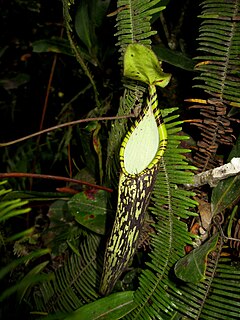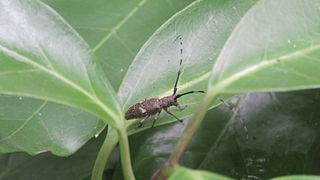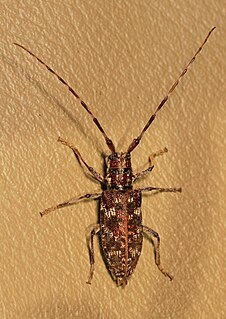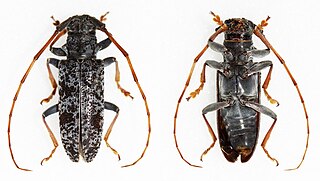
Rubus spectabilis, the salmonberry, is a species of bramble in the rose family Rosaceae, native to the west coast of North America from west central Alaska to California, inland as far as Idaho. Like many other species in the genus Rubus, the salmonberry plant bears edible fruit, typically yellow-orange or red in color, resembling raspberries in appearance.

Nepenthes spectabilis is a tropical pitcher plant endemic to Sumatra, where it grows at elevations of between 1400 and 2200 m above sea level. The specific epithet spectabilis is Latin for "visible" or "notable".

Gymnopilus junonius is a species of mushroom in the family Cortinariaceae. Commonly known as the spectacular rustgill, this large orange mushroom is typically found growing on tree stumps, logs, or tree bases. Some subspecies of this mushroom contain the neurotoxic oligoisoprenoid gymnopilin.

Monochamus is a genus of longhorn beetles found throughout the world. They are commonly known as sawyer beetles or sawyers, as their larvae bore into dead or dying trees, especially conifers such as pines. They are the type genus of the Monochamini, a tribe in the huge long-horned beetle subfamily Lamiinae, but typically included in the Lamiini today.

Tahina spectabilis, the tahina palm, is a species of gigantic palm that is found only in the Analalava District of northwestern Madagascar. It can grow 18 m (59 ft) tall and has leaves over 5 m (16 ft) across. An individual tree was discovered when in flower in 2007; it was first described the following year as a result of photographs being sent to Kew Gardens in the United Kingdom for identification. The palm is thought to live for up to fifty years before producing an enormous inflorescence and subsequently dying. Fewer than one hundred individuals of the species are thought to exist and the International Union for Conservation of Nature has rated it as "critically endangered".

Monochamus scutellatus, commonly known as the white-spotted sawyer or spruce sawyer or spruce bug, is a common wood-boring beetle found throughout North America. It is a species native to North America.

Bougainvillea spectabilis, also known as great bougainvillea, is a species of flowering plant. It is native to Brazil, Bolivia, Peru, and Argentina's Chubut Province.

Monochamus dubius is a species of beetle in the family Cerambycidae. It was described by Charles Joseph Gahan in 1894. It is known from India, Thailand, Myanmar, Vietnam, Taiwan, and China.

Monochamus subfasciatus is a species of beetle in the family Cerambycidae. It was described by Henry Walter Bates in 1873. It is recorded from Japan where it infests Japanese red pine and is a vector of the nematode Bursaphelenchus doui.
Monochamus adamitus is a species of beetle in the family Cerambycidae. It was described by James Thomson in 1857. It is known from Tanzania, Sierra Leone, Angola, Ghana, Mozambique, the Ivory Coast, Senegal, the Democratic Republic of the Congo, Malawi, and Zimbabwe.
Monochamus griseoplagiatus is a species of beetle in the family Cerambycidae. It was described by James Thomson in 1858. It is known from Sierra Leone and Gabon.

Monochamus clamator, the spotted pine sawyer, is a species of beetle in the family Cerambycidae. It was described by John Lawrence LeConte in 1852.

Monochamus galloprovincialis, the pine sawyer beetle, also referred to as the black pine sawyer beetle, is a species of beetle in the family Cerambycidae. It was described by Olivier in 1795, originally under the genus Cerambyx. It has a wide distribution, occurring naturally throughout Europe and the Caucasus. It has also been introduced into the Canary Islands. It serves as a vector for the parasitic nematode species Bursaphelenchus xylophilus, and also acts as a host to the parasitoid wasp species Dolichomitus tuberculatus.

Monochamus irrorator is a species of beetle in the family Cerambycidae. It was described by Chevrolat in 1855, originally spelled as "Monohammus" irrorator. It is known from the Republic of the Congo and Nigeria.
Monochamus leuconotus is a species of beetle in the family Cerambycidae. It was described by Francis Polkinghorne Pascoe in 1869, originally under the genus Anthores. It is known from Tanzania, Cameroon, Malawi, Kenya, Mozambique, Namibia, South Africa, Uganda, the Democratic Republic of the Congo, Zambia, Angola, and Zimbabwe. It feeds on Coffea arabica.

Monochamus maculosus, the spotted pine sawyer, is a species of beetle in the family Cerambycidae. It is known from Canada and the United States, and was formerly known as Monochamus mutator.
Monochamus ruspator is a species of beetle in the family Cerambycidae. It was described by Johan Christian Fabricius in 1781, originally under the genus Lamia. It has a wide distribution throughout Africa.

Monochamus sartor is a species of beetle in the family Cerambycidae. It was described by Johan Christian Fabricius in 1787, originally under the genus Lamia. It is known from throughout Europe, as well as in Kazakhstan, Mongolia, North Korea and South Korea. It is rated by the IUCN as Least Concern.
Monochamus thomsoni is a species of beetle in the family Cerambycidae. It was described by Chevrolat in 1855, originally under the genus Monohammus. It has a wide distribution throughout Africa. It contains the subspecies Monochamus thomsoni marshalli.

Monochamus sartor urussovii is a subspecies of beetle in the family Cerambycidae. It was described by Fischer von Waldheim in 1806. It has been recorded in Eastern and Northern Europe and Northern Asia. It is a vector of the nematode Bursaphelenchus mucronatus. Larvae burrow into the wood of various conifer species and can be a tree pest, as feeding damage reduces the value of the timber.















